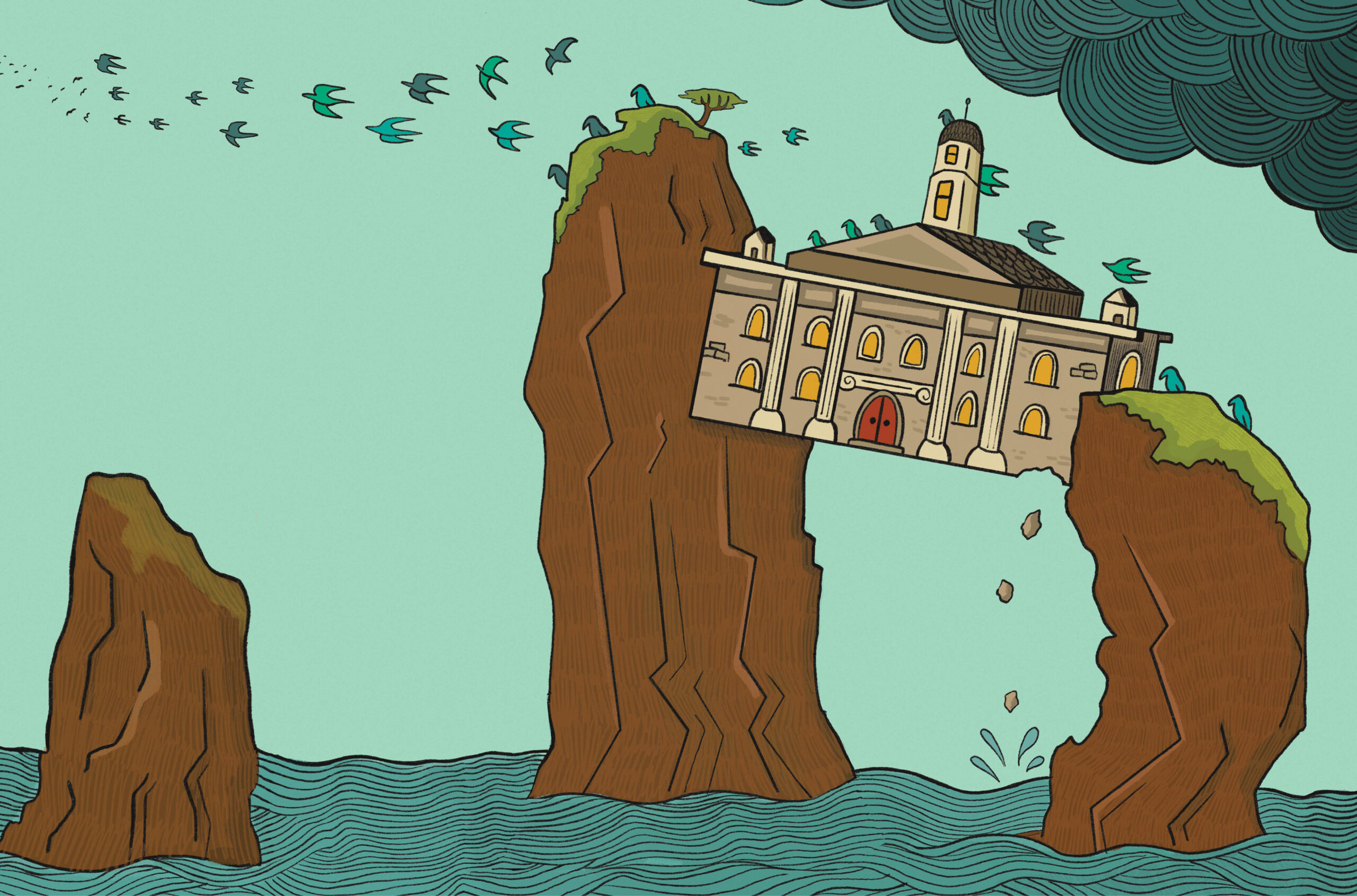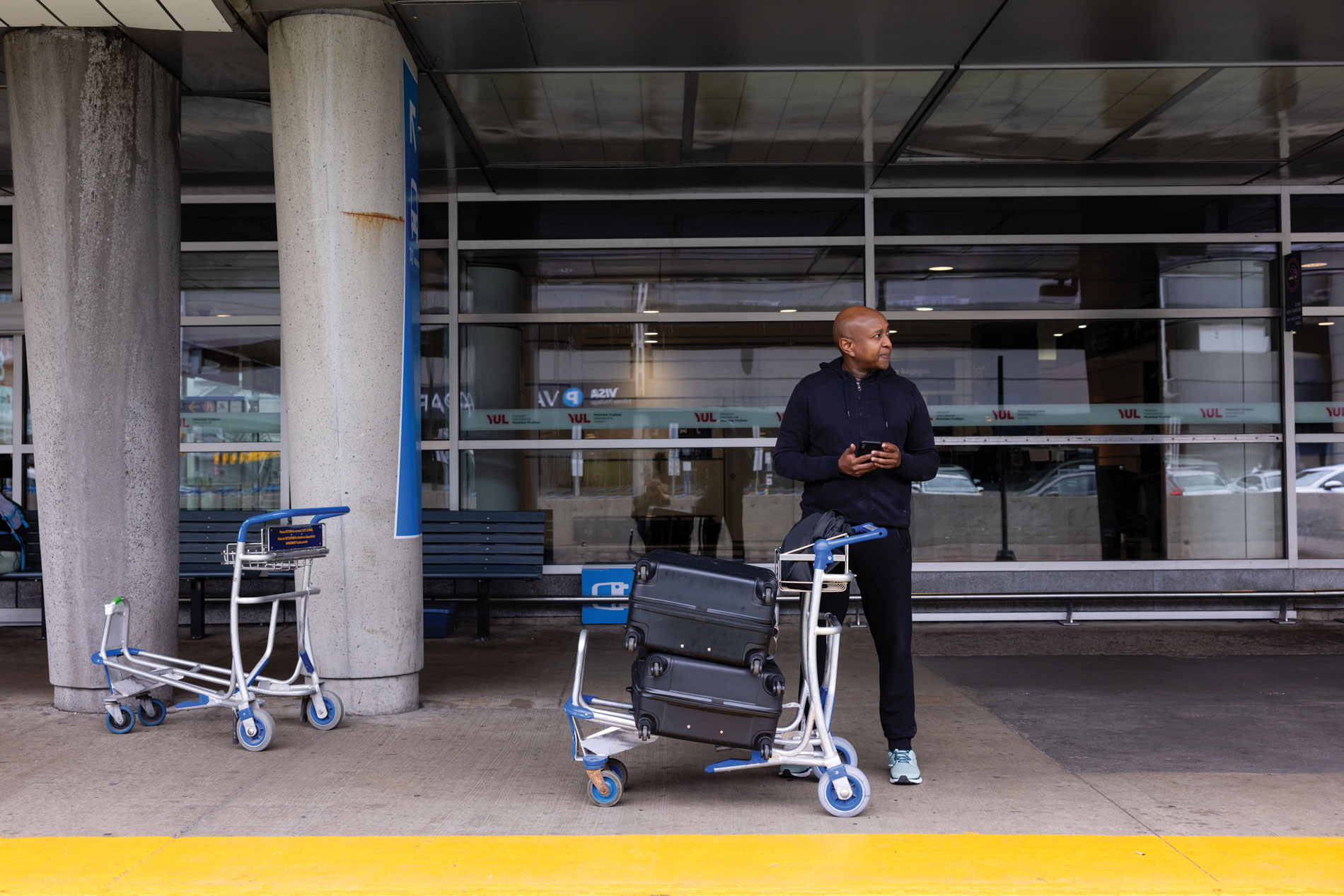The challenges facing Nova Scotia’s postsecondary institutions
Unexpected government policy changes have choked off revenues while rising costs threaten to topple painstakingly balanced budgets.

Welcome to Nova Scotia: your gateway to extraordinary experiences and endless opportunities!” reads the EduNova homepage. The cooperative in international student recruitment works to “champion Nova Scotia as a leader in the international student experience while advancing social and economic growth in the province.” That mission – which once seemed so straightforward – has become much more challenging in the last year. So has the job of running the province’s universities, thanks to changing federal and provincial government policies and a lack of consultation with administrators.
The country’s second-smallest province is home to 10 universities – the highest concentration of institutions per capita in the country – and an extensive community college system consisting of 14 campuses. Of the 10 universities, six are situated in the capital city of Halifax: Dalhousie, Saint Mary’s (SMU) and Mount Saint Vincent (MSVU) Universities, Nova Scotia College of Art and Design University (NSCAD), Atlantic School of Theology (AST) and the University of King’s College. The remainder are sprinkled throughout the province: Cape Breton University (CBU) in Sydney, St. Francis Xavier University (StFX) in Antigonish, Acadia University in Wolfville and Université Sainte-Anne in Church Point.
According to the Association of Atlantic Universities (AAU), the number of full-time graduate and undergraduate students in Nova Scotia in 2024 was 44,140. An additional 11,052 students were enrolled in programs at Nova Scotia Community College (NSCC).
Those enrolment numbers are significant in a province that has a population of just over 1 million, according to Statistics Canada, and is facing demographic challenges as the populace ages and as the number of deaths outpaces the number of births. The provincial government, led by Premier Tim Houston, has been relying heavily on immigration to grow the population; between July 2022 and July 2023, Nova Scotia’s population grew faster than during any other period in its history, due in large part to a sharp increase in net non-permanent residents (a large portion of whom are international students) as well as immigration and interprovincial migration. The province also has its eye on doubling the population to two million by 2060. That means the attraction and retention of students – particularly international students – plays a vital role in supporting the province’s economic goals.
A deep concern
In October 2023, 14,567 international students were enrolled at Nova Scotia-based universities. But in December 2023, Immigration, Refugees and Citizenship Canada (IRCC), led by then-Minister Marc Miller, announced an increase of more than 100 per cent in the cost-of-living financial requirement of international students, from $10,000 to $20,635. Then, in January 2024, IRCC made a snap announcement of a 35 per cent cut in the number of international student permit applications it would allocate across the country. That announcement was followed by another in September 2024 suggesting a further 10 per cent nationwide cut was coming in 2025.
By October 2024, the number of international students enrolled at Nova Scotia universities had dropped 14.4 per cent, to 12,476, according to numbers provided by the AAU.
The federal government’s moves caught universities off guard. “These policy changes were a real kick to positive trends in previous years,” says Peter Halpin, executive director of the AAU. “[They] have implications, not just for our universities, but for regional economy and population growth strategies.”
In response, the AAU commissioned a study by Gardner Pinfold Consultants to measure the economic impact of the IRCC’s cap on international students throughout the Atlantic provinces. The report found that the shortfall between actual and expected international student enrolment between 2023-24 and 2024-25 resulted in an estimated regional loss of $163 million in spending, $165 million in provincial GDP, $94 million in provincial income and 2,231 full-time equivalent jobs, in addition to a decline of $22 million in provincial tax revenues and $17 million in federal taxes lost. And with more than half of the international students in the Atlantic region, Nova Scotia is experiencing the greatest impact from the cuts.
But not all universities in Nova Scotia were affected equally. The province was tasked in 2024 with disbursing its allocation of 11,565 international study permits (out of 12,900 in total, including private colleges) among all 10 universities and NSCC. As with all provinces, international students would require a Provincial Attestation Letter (PAL) confirming that the student has a place within the province’s allocation under the cap.
CBU was hardest hit. The school, which began as Xavier Junior College in 1951, became Cape Breton University in 2005. That year, the institution had 2,905 full-time students, 208 of which were international students. The number gradually rose (there were 721 visa students in 2015; 1,982 in 2018; 3,952 in 2022) until 2023, when the number ballooned to 6,939 out of a total full-time student body of 9,138. That number of students overwhelmed the small city of Sydney, which has a population of around 30,000 – putting a strain on housing and employment.
IRCC’s changes meant CBU’s provincial allocation of international study permits in 2024 was 5,086 – down 52 per cent from the previous year. (The actual number of international students enrolled at CBU in 2024 was 5,764, which includes returning students who did not require a provincial attestation letter to apply for a visa because they already had a study permit.)
“The financial pressures on the postsecondary system are acute. I think those have been building up slowly over time.”
CBU president and vice-chancellor David Dingwall declined to be interviewed for this article, but he spoke with CBC Radio’s “Information Morning Cape Breton” on Jan. 2, about the impact of the international student cap. He acknowledged that CBU’s enrolment needed to be reined in, pointing out that the university had developed a strategic enrolment plan before “all of this” to take total enrolment back to 7,000. Now CBU is facing a loss of around 1,200 international students, which he said amounts to “anywhere between $15 and $20 million” in lost revenue.
“I’m disappointed in the Government of Canada for the way in which they have preceded on this particular topic,” he told CBC. “No consultation ever took place with universities across the country.”
Université Sainte-Anne, at the other end of the province, also took a hit. In 2024, international students at the small francophone university made up 26 per cent of the 560-strong student body, based on their enrolment data. “We’re highly dependent on international students,” says president and vice-chancellor Kenneth Deveau. Sainte-Anne’s international recruiting efforts focus primarily on French-speaking sub-Saharan African countries.
Dr. Deveau says these potential students typically face challenges in obtaining the required documentation and securing funds, which means the conversion rate – the number of students who are admitted versus the number who enrol – can be less than five per cent.
“[Admitting] an international student is a long and cumbersome process and much more so now that these [PALs] are in place,” says Dr. Deveau. “We used to admit some 2,000 students a year to get maybe 15 new students.” Sainte-Anne’s 2024 provincial allocation was 962, down 34 per cent from 2023. Dr. Deveau says the university admitted “somewhere around 350 students.” In the end, just 146 international students enrolled.
“There’s a budget impact there for us,” he says. “We’re looking at probably a half a million-dollar revenue hit on a $25 million budget. That’s not insignificant.”
Even the NSCC system is impacted. President Don Bureaux says international students in 2023 made up about 10 per cent of the student body, but the most recent federal limits will take that down to three per cent in September 2025. “It is a hit to us,” he says. “It’s going to hurt us financially. We’re going to have to make some changes.”
The long-term impacts of the IRCC policies are a major priority for the AAU across the board. “We have a deep concern that Canada’s brand internationally has been badly tarnished by these IRCC policies,” says Mr. Halpin, noting that the AAU made “overtures” to then-Minister Miller to propose a program that aligns with government goals while recognizing the importance of international students to the region.
Robert Summerby-Murray, outgoing president of SMU, chair of the AAU, chair of the board of directors of EduNova and vice-chair of the Council of Nova Scotia University Presidents (CONSUP) says recruitment has become a challenge for all of Nova Scotia’s postsecondary institutions, including his own.
“These policy changes were a real kick to positive trends in previous years.”
“People are just not applying, because the message we get from our recruiters is: Canada is not welcome to me. I will apply elsewhere,” he says. “Canada was the number one destination for international students globally and we threw that away because of the miscalculation and misunderstanding on the part of the government of Canada and the lack of action on the part of our provincial governments.”
Dr. Summerby-Murray says the federal government failed to understand that when it “turned the tap off” on Jan. 28, 2024, the flow could not just be “turned back on again” on March 31. “That was a gross assumption; a complete miscalculation,” he says. “For many universities, and Saint Mary’s is one of them, we are looking at [losing] 50 per cent of our international students.”
That created a significant challenge for an institution that was already struggling with international student enrolment. In 2023, SMU faced a deficit of $9.7 million in its operating fund; by 2024, the deficit was down to $3.3 million.
Bilateral agreements
The IRCC’s policy changes weren’t the only challenges that caught Nova Scotia’s postsecondary sector by surprise in 2024. In early February, two weeks after the federal government’s announcement of the cap on new international student study permits for Nova Scotia, then-Minister of Advanced Education Brian Wong declared that the existing five-year memorandum of understanding between the province and Nova Scotia’s universities would be replaced by separate bilateral one-year funding agreements
with each of the province’s 10 universities.
Universities did not see this coming. CONSUP released a statement calling the one-year funding plan “extraordinarily distressing news.” Mr. Dingwall, chair of CONSUP, said in the statement that the lack of consultation or negotiation “undermines any sense of partnership, collaboration or vision for the future of one of the province’s most strategically important sectors.”
The agreements placed a two per cent cap on tuition increases (previously capped at three per cent) for all Nova Scotia undergraduate students, a minimum tuition increase of nine per cent for first-year international undergraduate student tuition (except for Dal and the University of King’s College, because of an increase in the previous year), and tied a portion of funding to performance targets that included a requirement to fill health program seats to an average enrolment rate of at least 97 per cent. They also required universities in Halifax and Cape Breton to add more student housing options.
The province provided a two per cent increase in annual operating grants for most universities, up from one per cent in the expiring MOU signed in 2019. Dal’s grant was the same as it had been in 2023-24.
“Government has successively reduced funding at the provincial level, so our base operating grants as a percentage of operating have reduced probably 10, 12 percentage points over the last decade,” says
Dr. Summerby-Murray. “At the same time, our costs of operating our universities – labour costs, utilities costs – continue to rise at four and a half or so per cent each year, so provincial government funding has
not kept pace with that.”
By September, Dal – the largest degree-granting institution in the province with more than 21,000 students in 2024 – announced it was facing a budget shortfall of $18 million and instituting a hiring freeze. In an internal memo, president and vice-chancellor Kim Brooks cited declining international enrolments through the COVID years and “the events of this past year – both geopolitical and related to changing government policy” – as factors in the university’s challenges.
“The financial pressures on the postsecondary system are acute. I think those have been building up slowly over time,” says Dr. Brooks in an interview. She acknowledges one way Dal has traditionally addressed those pressures has been through the admission of international students, who pay tuition as though they’re not at publicly funded institutions.
Dr. Brooks doesn’t see any sort of potential rescue by the provincial government in the future. “I think it is probably unrealistic for universities in this province to imagine that there is going to be a provincial government funding increase that will fix this challenge in a way that won’t mean we’ll have to do at least some work to think about how we design the kinds of offerings we have,” she says.
Affordability
Meanwhile, postsecondary students in Nova Scotia are struggling to afford an education.
“We’ve had the highest tuition for domestic undergraduate students from within the province for quite some time,” says G Saleski, executive director of StudentsNS, a self-described not-for-profit and non-partisan advocacy group that represents Nova Scotia postsecondary students. Domestic undergraduate students in Nova Scotia pay 36.5 per cent more than the national average for full-time tuition – according to data from Higher Education Strategy Associates – although the province has a tuition bursary for domestic undergraduate students amounting to $1,283 for full-time students. Dr. Summerby-Murray says CONSUP has been lobbying to see that bursary increased because it hasn’t changed in about a decade.
Many areas of the province lack adequate affordable housing; campus food banks are also under growing pressure to help reduce the financial burden on students.
“When universities are struggling to keep funds coming through the door with decreased budgets from the government, it’s of course students that are on the receiving end of the dollar signs going up,” says Mx. Saleski.
Strategic alignment with government
Nova Scotians are also facing a growing inability to access health care, with failing health infrastructure and shortfalls in the numbers of available doctors and other healthcare workers. The provincial government’s one-year bilateral agreements with universities include requirements for Acadia, CBU, Dal, MSVU and StFX to provide proof that 97 per cent of the seats in their health programs are filled in order to meet the province’s payment terms and obtain a portion of their funding. All universities are also required to develop strategic alignment plans that outline how they will advance government priorities.
“I don’t think it’s anything new that governments would be looking for more direct outcomes – outcomes that are connected specifically to particular demand in the job market,” says Dr. Summerby-Murray. “We are in a period of a greater emphasis on vocation rather than long-term education. And at the university level, we need to be cognizant of that. We need to show the link.”
By late January 2025, Dal had met the requirement of reaching 97 per cent of its seat allocations in health programs and had submitted a required strategic alignment plan, triggering the release of $34 million in provincial government holdbacks, according to a more recent internal memo that was circulated. That won’t relieve the budget pressures on the university entirely but has helped with the current year’s shortfall; in January 2025 the school was still facing a $10 million budget deficit – the first time Dal has ended the year with a deficit since the early 2000s. (Dal’s budget advisory committee requires that the operating budget must be balanced.)
MSVU’s May 2024 budget showed a $200,000 shortfall, which it attributed to the province’s two per cent increase to the university’s operating grant “while the cost of operating the institution is rising and at a rate that outpaces the two per cent increase.” The budget noted that this year’s international student enrolment projections were established at the same number as last year, “as it is difficult to predict what the actual impacts of the Federal government’s unexpected policy change will be.”
StFX’s 2024-25 budget reflects a deficit of nearly $5 million; the document pointedly says: “The government has decided to abandon the MOU process and the consultations that occurred with the university presidents. Instead, the government has mandated a one-year agreement. The terms of this agreement were not discussed with the university presidents before being presented to the public.” It also notes “vulnerability around enrolment” and expresses concern that “if the target of 97 per cent of [nursing] enrolment is not achieved, the university will lose three per cent from the operating grant and may not get the full allotment of the nursing grant.
Surprises keep coming
The provincial government continues to spring surprises on the postsecondary sector. Since a provincial election in November 2024 that led to a supermajority for Premier Tim Houston’s Progressive Conservatives, there had been little to no communication about what was coming until February 2025, when newly appointed Minister of Advanced Education Brendan Maguire, who declined to be interviewed for this story, introduced Bill 12 – An Act Respecting Advanced Education and Research.
The bill would amend the University Accountability and Sustainability Act to give the minister sweeping authority over the composition of boards of governors as well as the authority to require a university experiencing financial hardship to “enter into a revitalization process” in which the province can withhold funds if the institution fails to comply. It would also give NSCC the power to grant undergraduate degrees.
The day before, the Conservatives had also introduced an omnibus bill that would have hindered the role of the auditor general. After significant public criticism, the premier backed down, and on March 4, 2025, Nova Scotia Auditor General Kim Adair released her report on funding to universities, which found that the Department of Advanced Education was not effectively monitoring or holding universities accountable for public funds amounting to more than $2.5 billion over the last five years.
And there’s still no clarity on international student allocations.
On Jan. 24, IRCC announced the 2025 provincial allocations under the international student cap. Nova Scotia will receive 8,297 permits. Master’s and doctoral students will now also be required to submit PALs. At the time of writing, the minister had not yet allocated those permits to the universities.
That uncertainty, combined with continued questions around what’s coming when the current bilateral agreements expire on March 31, weighs on Peter Halpin and the members of the AAU.
“We have to be optimistic about the future,” he says. “All of our universities have plans and they very much want to execute those plans, but they are publicly funded universities. And to that end, they require greater support from both the federal and provincial governments to make these plans come to fruition to the benefit of students.”








Post a comment
University Affairs moderates all comments according to the following guidelines. If approved, comments generally appear within one business day. We may republish particularly insightful remarks in our print edition or elsewhere.
2 Comments
They are not publicly funded universities, they are universities that receive public funding, somewhere around 20%. In what world does a 20% shareholder get to call the shots, this gross government overstep.
On one hand, the mismanagement of the international student permits by the federal government and unclear direction from the provincial have left NS universities in a tricky position. On the other – it is hard to feel bad for them.
Treating international students as cash cows to prop up a bottom line and build new infrastructure instead of investing time and money into research and development to evergreen these cash flows has come back to bite them hard. This article does an admirable job of laying out how we got here – but the universities themselves aren’t victims.
They are complicit in their current difficulties and frankly require significant reform in their governance – which was one of the findings of the Auditor General report cited in the article.